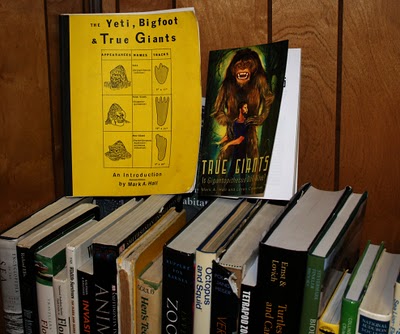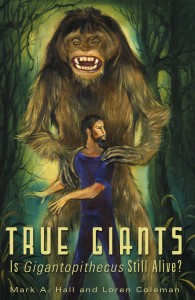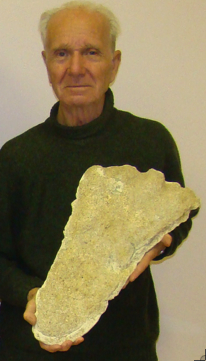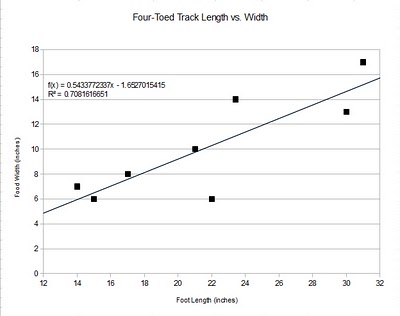Lord Geekington on True Giants
Posted by: Loren Coleman on March 14th, 2011

Cameron McCormick has read and reviewed my latest new book, True Giants: Is Gigantopithecus Still Alive?, the one which I coauthored with Mark A. Hall in 2010. McCormick begins:

I was thrilled to learn that Mark A. Hall and Loren Coleman wrote a new book on True Giants. My copy of Mark A. Hall’s self-published The Yeti, Bigfoot & True Giants (1997) was read and re-read to the point of near-disintegration, so I’m anxious to both have a more structurally sound tome on ‘True Giants’ and to see how the hypothesis has evolved.
McCormick has much to say about the book, mostly constructively negative, and I will let those interested read his critique. Nevertheless, it is reviews like McCormick’s that drive me on to gather more evidence. His attention to detail, for instance, with the footcasts let’s you know he actually read the entire book:
By far the most interesting evidence presented for ‘True Giants’ are tracks with only 4 visible toes. I counted 14 reported cases in True Giants, with most being reported from western North America (Washington, Oregon, Idaho, British Columbia, Alberta, Manitoba), but also eastern North America (Pennsylvania, Mississippi), Central Asia (Tajikistan), and Southeast Asia (Indonesia, Malaysia). They range in length from 14 to 31 inches (n = 14, median = 20″, mode = 20″, average = 21″, stdev = 5″) and in width from 6 to 17 inches (n = 8, median = 9″, mode = 6″, average = 10″, stdev = 4″). Unfortunately, only 3 of the tracks have been depicted (2 of which are in Mark A. Hall’s prior book): the 30″ x 13″ track from Johor has very round toes in a slightly sloping line and tapers into a pronounced heel; the 19.25″ long Tajikistan track seems to have a more rounded heel and pronounced sloping toe-line; the 15″ x 6″ Mississippi track seems to have a very strait toe-line and round heel (as well as a possible projection from the side, where an opposing ape-like hallux could be). As for how the length and width compare, it isn’t a particularly great trend.
I would have preferred it if the authors documented all of the known 4-toed tracks. Are there casts? Is there similar overall morphology? If there evidence of dermal ridges or differing depths within the track which would be difficult to fake? The tracks are potentially very interesting, but ultimately left very mysterious by the book.
It’s noteworthy that 10 other footprints were mentioned where the number of toes is not mentioned; these appear to have been connected to ‘True Giants’ due to their size and location – even though you’d think 4 toes would be one of the first things mentioned. One report from Ballachulish, Scotland specifically mentions toes, but not the number. I found two instances where legends stated that the toes of the giants were “normal” and none mentioned an odd number, demonstrating the tenuous connection between legendary giants and ‘True Giants’.

Clearly the footprint section of the book needs to be strengthened with more data. Of course, part of the problem is that if people don’t understand that researchers will take their reports of really giant footprints seriously, they are not reporting them.
I sincerely appreciate Cameron McCormick taking the time to fully read, minutely analyze, and deeply critique this book.
The tome is a radical approach to material found in various fields that may apply to the survival of Gigantopithecus. A reading, such as conducted by McCormick, shines a light on weaknesses in our arguments than rightfully need to be addressed. I acknowledge the value of his critique.
More photographs and discussion of the footprints, for example, need to be gathered, composed, and added to the future editions. Placing the concept out there was a major goal. But more should be developed, I agree. Already material is coming in from Russia that adds insights.

The Pamirs footprint with four toes found by Vadim Makarov.
This review by Cameron McCormick, hopefully, will lead to the enhancing of the case for True Giants, as responsible researchers share what they have filed away and ignored in their “Bigfoot files.”
Thank you Cameron for your fine review.

About Loren Coleman
Loren Coleman is one of the world’s leading cryptozoologists, some say “the” leading living cryptozoologist. Certainly, he is acknowledged as the current living American researcher and writer who has most popularized cryptozoology in the late 20th and early 21st centuries.
Starting his fieldwork and investigations in 1960, after traveling and trekking extensively in pursuit of cryptozoological mysteries, Coleman began writing to share his experiences in 1969. An honorary member of Ivan T. Sanderson’s Society for the Investigation of the Unexplained in the 1970s, Coleman has been bestowed with similar honorary memberships of the North Idaho College Cryptozoology Club in 1983, and in subsequent years, that of the British Columbia Scientific Cryptozoology Club, CryptoSafari International, and other international organizations. He was also a Life Member and Benefactor of the International Society of Cryptozoology (now-defunct).
Loren Coleman’s daily blog, as a member of the Cryptomundo Team, served as an ongoing avenue of communication for the ever-growing body of cryptozoo news from 2005 through 2013. He returned as an infrequent contributor beginning Halloween week of 2015.
Coleman is the founder in 2003, and current director of the International Cryptozoology Museum in Portland, Maine.











I think Loren and Mark A. Hall have to be commended for being brave enough to put the book out there. The scientific fraternity, whether cryptozoological or otherwise, is always loathe to accept change, new perspectives or refutation.
While I do not believe that large four-toed hominid footprints being found around the world are pointing towards Giganto, I do believe that the issue is worthy of further research.
My belief is that local morphology points towards local species and that whether four or five-toed, the prints left behind definately point to towards local populations of bi-pedal ape species.
From Sasquatch of the Pacific Northwest, to Skunk Ape of the Florida Everglades, to Australia’s Yowie and back, via Yeren, Mande Burung, Yeti and Kaptar (etc.), we are most likely dealing with separate species of giant, man-like (although not man) apes. Nothing I have encountered in my few years of research would lead me to believe all these ‘giant hairies’ are anything but.